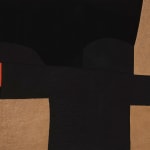

Alberto BURRI Italian, 1915-1995
Born in 1915 in Città di Castello, a small village in Umbria, Italy, Alberto Burri graduated in medicine in 1940 and was called to join the army as a physician the same year. In 1943 he was captured in Tunisia by the British, who handed him to the US army the following year. In the US, he is moved to a prisoner camp in Hereford, Texas, and held captive for 18 months. While interned, Burri began painting and making collages. At the end of the war, Burri returned to Italy, renounced his medical profession and dedicated himself full-time to art. After his first solo exhibition at the Galleria La Margherita, Rome, Burri travelled to Paris where he discovered the collages of Joan Miró and the richly textured works of Jean Dubuffet, infused with tar. In Italy, his connections with the Rome Art Club exposed him to the avant-garde realm of Futurist arte polimaterica, or "multimaterial" art.
His rapidly evolving ideas about art-making focused on off-beat materials such as burlaps, plastic sheets, molds, and tars, protruding, sculptural canvases that challenged traditional artistic norms. Like other artists who experienced World War II, Alberto Burri's art exudes torment, which emerges from the scars he inflicts on the materials he chooses to use.
His artistic journey reached across the Atlantic with his inaugural solo exhibitions in the United States in 1953, hosted at the Allan Frumkin Gallery in Chicago and the Stable Gallery in New York. The same year, his work was featured in the groundbreaking exhibition "Younger European Painters: A Selection (1953–54)" at the Solomon R. Guggenheim Museum. In a testament to his growing stature in the art world, the Carnegie Museum of Art in Pittsburgh organized a mid-career retrospective of his work in 1957. It was during those years that he married the American dancer-choreographer Minsa Craig, and from 1963 until 1991 they wintered in Los Angeles, where the artist began a dialogue with Minimalism, first with his series Cretti, and later with his last series Cellotex.
He began his series Cellotex in 1975, but he had been working with the material since the early 1950s in his famous Legni, Plastiche and Cretti as a supporting ground. He chose this title with a double L to distinguish his series from the brand name, Celotex. Celotex is an insulation board and acoustic paneling made with bagasse, the fibrous matter that remains after the pressing of sugarcane. Used by other artists purely as a support, for Burri Celotex is not just a base but an active part of the work. With the help of screwdrivers or knives, Burri scored and peeled the panel to create indentation and relief, sometimes exposing the fibrous surfaces. He then decided whether to leave the surface natural, like the desert sand surrounding his studio in LA, to color it black or red, a reminder of the fire of le Combustioni, or yet a mixture of the three, as in Cellotex, 1991. The composition, created in his previous series by the sole use of chance, begins to be planned and, as proven by art historian Bruno Corà, follows the harmony of the golden section, seeking for ethereal beauty.
Provenance
Galerie Sapone, Nice
Private Collection, Monaco (2000)
Private Collection, gifted from the above (2000)
Galleria Sprovieri, London
Private Collection, NY
Literature
B. Corà, Alberto Burri: General Catalogue Painting 1979-1994 Volume III, Città di Castello, 2015 (illustrated in colour, p.332 no. 2176)


